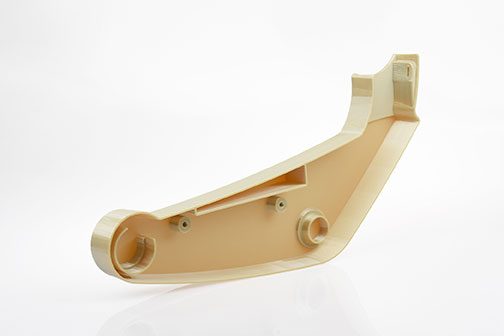Editor’s Pick: 3D Print Certified Aircraft Interior Parts

A Stratasys Fortus 900mc Production 3D Printer newly reconfigured with specialized hardware and software to deliver highly repeatable mechanical properties made this aircraft interior armrest component with certified ULTEM 9085, a strong, lightweight thermoplastic that meets aircraft flame, smoke and toxicity regulations. Image courtesy of Stratasys Ltd.
Latest News
July 26, 2017
Sometimes I mutter “that won’t fly” at new products announcements crossing my desk. When today’s Editor’s Pick of the Week came my way, the first thought was this should literally take off.
Stratasys recently announced its new Aircraft Interiors Certification Solution for 3D printing aircraft interior parts that meet demanding FAA (Federal Aviation Administration) and EASA (European Aviation Safety Agency) certification requirements. Right now, the solution is in a qualification program under FAA oversight at the National Center for Advanced Materials Performance (NCAMP), a part of the National Institute of Aviation Research at Wichita State University. Stratasys expects that process to conclude in late summer/early fall.
For engineers and the suits at aerospace companies as well as their suppliers, what NCAMP qualification of a 3D printing process means is that it should be less arduous getting FAA and EASA certification. You also should be able to fabricate more flight-certified parts more quickly.
 A Stratasys Fortus 900mc Production 3D Printer newly reconfigured with specialized hardware and software to deliver highly repeatable mechanical properties made this aircraft interior armrest component with Certified ULTEM 9085, a strong, lightweight thermoplastic that meets aircraft flame, smoke and toxicity regulations. Image courtesy of Stratasys Ltd.
A Stratasys Fortus 900mc Production 3D Printer newly reconfigured with specialized hardware and software to deliver highly repeatable mechanical properties made this aircraft interior armrest component with Certified ULTEM 9085, a strong, lightweight thermoplastic that meets aircraft flame, smoke and toxicity regulations. Image courtesy of Stratasys Ltd.But that’s just a start. This also means you can design lighter components or open up new lines of business manufacturing specialized touches for customer styles. You should see fewer spare parts sitting on expensive warehouse shelves as well.
The Aircraft Interiors Certification Solution has two key components. The first is a new configuration of the Fortus 900mc Production 3D Printer. With its 36x24x36 in. (914.4x609.6x914.4mm) build size, it’s Stratasys’ largest-capacity FDM (fused deposition modeling) additive manufacturing system. This edition features specialized hardware and software for 3D printing parts with highly repeatable mechanical properties—an absolute must in aircraft component manufacturing. If you already deploy at Fortus900mc, you can upgrade your existing units with a kit.
Second is Certified ULTEM 9085 resin. This strong, lightweight thermoplastic meets aerospace flame, smoke and toxicity regulations, according to Stratasys. “Certified” means that it’s produced in small batches, undergoes frequent testing and comes with all the various documentation providing full traceability and demonstrating compliance with airworthiness regulations.
The Aircraft Interiors Certification Solution has many other components like NCAMP-approved B-Basis design allowables datasets as well as a toolkit to calibrate and validate the Fortus 900mc’s operations. Stratasys also provides on-site technical support for system setup validation before equivalency testing. Many of these are covered in today’s main write-up, and deeper details are available from the links at the end of that content. Hit today’s Editor Pick of the Week link and take off.
Thanks, Pal. – Lockwood
Anthony J. Lockwood
Editor at Large, DE
Subscribe to our FREE magazine, FREE email newsletters or both!
Latest News
About the Author
Anthony J. Lockwood is Digital Engineering’s founding editor. He is now retired. Contact him via [email protected].
Follow DE







